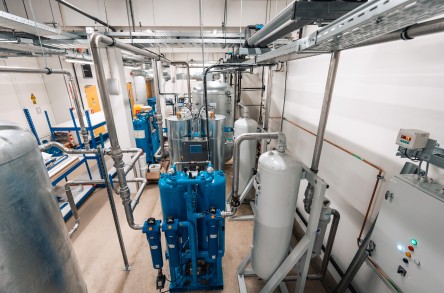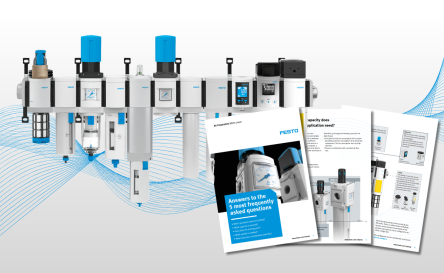Importance of compressed air quality and purity
Compressed air is used in a wide range of industries—from food and beverage to pharmaceuticals, electronics, and automotive manufacturing. Contaminants such as water vapor, oil, and particulates can compromise product quality, damage equipment, and even pose safety risks. Poor air quality can lead to unplanned downtime, increased maintenance costs, and product recalls in regulated industries.
For example, in a food processing plant, oil or moisture in the air line can contaminate packaging or ingredients, leading to health risks and regulatory violations. This example highlights the importance of tailoring air preparation to the specific needs of each application.
Additional Considerations:
- Energy Efficiency: Contaminated compressed air systems often require more energy to operate due to pressure drops and equipment wear. Maintaining clean, dry air reduces energy consumption and operational costs.
- Environmental Impact: Proper condensate management and oil removal prevent environmental contamination, helping companies meet sustainability goals.
- Safety: Contaminated air can cause malfunction of pneumatic tools or actuators, potentially leading to hazardous situations.
Understanding ISO 8573
The international standard ISO 8573 provides a comprehensive framework for measuring and classifying compressed air contaminants. It breaks down air quality into three main categories:
- Particulate – Solid particles like dust, rust, and scale.
- Water – Present as vapor, liquid, or aerosol.
- Oil – Including liquid oil, oil aerosols, and oil vapor.
Each category is assigned a class rating, with Class 1 being the highest quality. For example, ISO 8573-1:2010 is the most commonly referenced part of the standard, specifying the purity classes for compressed air. A typical classification might look like ISO 8573-1:2010 [1:2:1], meaning Class 1 for particles, Class 2 for water, and Class 1 for oil.
Additional Notes:
- ISO 8573-1 defines purity classes numerically from 0 (best) to 9 (worst), with detailed limits for particle size and concentration, dew point temperatures, and oil content.
- The standard also includes parts addressing test methods (ISO 8573-2 to ISO 8573-9), providing guidance on how to measure contaminants accurately.
- Some industries require even stricter standards or additional certifications (e.g., ISO 13485 for medical devices).
Technologies and processes for achieving required air quality
To meet the desired ISO 8573 class, various air treatment technologies are used in combination. These technologies are typically arranged in stages to progressively remove contaminants.
Water Separation
Water is one of the most common and damaging contaminants in compressed air. It can cause corrosion, damage pneumatic tools, and affect product quality. Key technologies include:
- Cyclone Water Separators: Use centrifugal force to remove bulk water from the air stream, typically installed immediately after the compressor.
- Refrigeration Dryers: Cool the air to condense and remove water vapor. Ideal for general-purpose applications with moderate dew point requirements.
- Desiccant/Absorption Dryers: Use hygroscopic materials to absorb moisture, achieving very low dew points (down to -70°C or lower). Essential for critical applications like pharmaceuticals and electronics.
- Membrane Dryers: Use selective permeation to remove water vapor. Compact and suitable for point-of-use drying in smaller systems or remote locations.
Particulate Filtration
Solid particles can originate from ambient air, the compressor, or the piping system. To remove them:
- Pre-filters: Capture larger particles and protect downstream equipment.
- High-efficiency filters: Remove fine particulates down to sub-micron levels, ensuring clean air for sensitive processes.
- HEPA Filters: For ultra-clean environments, such as pharmaceutical or semiconductor manufacturing, HEPA filters may be used to remove particles down to 0.3 microns or smaller.
Oil Removal
Oil contamination can come from lubricated compressors or ambient sources. Removal methods include:
- Coalescing Filters: Capture oil aerosols and fine particulates.
- Activated Carbon Filters: Remove oil vapors and odors, often used as a final polishing stage.
- Oil-free Compressors: In applications demanding zero oil contamination, oil-free compressors eliminate the risk of oil ingress.
Condensate Management
Collected water and oil must be safely discharged:
- Automatic Condensate Drains: Remove accumulated liquids from filters and dryers without manual intervention.
- Oil/Water Separators: Ensure environmentally compliant disposal of condensate, separating oil from water before discharge.
- Monitoring Systems: Advanced sensors and IoT-enabled devices can provide real-time monitoring of condensate quality and system status.
Industry-specific examples
Different industries, unique requirements
Different industries have unique requirements for compressed air quality:
- Food & Beverage: In bottling plants, compressed air is used to blow-mold plastic bottles and clean packaging. ISO Class 1-2-1 is often needed to avoid contamination of consumables.
- Pharmaceutical: In tablet manufacturing, compressed air transports powders and runs cleanroom equipment. Ultra-clean air (ISO Class 1-1-1) is essential to prevent cross-contamination.
- Semiconductor: Microchip fabrication requires extremely dry and oil-free air to avoid microscopic defects. ISO Class 1-1-1 or better is typically mandated.
- Medical Devices: Compressed air used in surgical tools or sterilization must meet stringent hygiene standards, often ISO Class 1-2-1 or higher.
- Automotive: Paint booths require dry, oil-free air to ensure a flawless finish. ISO Class 2-2-2 is commonly used.
- Packaging: Pneumatic systems in packaging lines require clean, dry air to avoid jams and ensure consistent performance.
Emerging Industry Needs:
- Renewable Energy: Wind turbine blade manufacturing and solar panel production require high-quality compressed air to ensure defect-free components.
- Additive Manufacturing (3D Printing): Requires ultra-clean, dry air to avoid contamination and ensure print quality.

Case Study: Festo & TNO
Festo partnered with TNO to enhance compressed air quality at the Van Leeuwenhoek Laboratory, a leading research facility in nanotechnology. Faced with the challenge of needing both increased capacity and superior air quality, Festo conducted a comprehensive pre-audit and collaborated with Royal HaskoningDHV to design a two-tier compressed air system.
This system adheres to ISO 8573 standards, delivering extremely dry compressed air (class 2.1.1) for sensitive tests while providing standard quality air (class 2.4.1) for other applications. This tailored solution improved reliability and efficiency, optimized energy consumption, and demonstrated the critical role of ISO standards in achieving high-quality compressed air for industrial needs.
Common mistakes in air preparation (and how to avoid them)
Even with the best intentions, many factories and maintenance engineers make avoidable mistakes when designing or maintaining their air preparation systems:
- Undersizing Equipment: Choosing filters or dryers too small for the flow rate leads to pressure drops and poor performance.
- Neglecting Maintenance: Dirty filters and clogged drains reduce efficiency and can lead to contamination.
- Improper Placement: Installing dryers or filters too far from the point of use can allow recontamination.
- Ignoring Ambient Conditions: High humidity or dusty environments require more robust air treatment solutions.
- Lack of Regular Testing: Without periodic air quality testing, contamination issues can go unnoticed until they cause failures.
Avoiding these pitfalls starts with a proper system assessment and regular monitoring of air quality.
Compressed air quality checklist: ensuring compliance with ISO 8573
1. Assess Application Requirements
- Identify industry-specific air quality needs
- Determine required ISO 8573 purity class (particles, water, oil)
- Understand sensitivity of equipment and processes to contaminants
2. Evaluate Current Compressed Air System
- Conduct baseline air quality testing (particles, dew point, oil content)
- Review existing filtration and drying equipment capacity
- Inspect placement of air treatment components relative to point of use
3. Design and Implement Air Treatment Solutions
- Select appropriate water separators (cyclone, refrigeration, desiccant, membrane)
- Choose suitable particulate filters (pre-filters and high-efficiency filters)
- Incorporate oil removal systems (coalescing filters, activated carbon filters)
- Install automatic condensate drains and oil/water separators
- Consider use of oil-free compressors where applicable
4. Maintenance and Monitoring
- Schedule regular filter and desiccant replacements
- Clean and inspect condensate drains periodically
- Monitor pressure drops across filters and dryers
- Implement periodic air quality testing per application risk level
- Train personnel on system operation and maintenance best practices
5. Documentation and Continuous Improvement
- Keep detailed records of maintenance activities and test results
- Document any system modifications or upgrades
- Review system performance regularly and adjust as needed
- Stay updated on industry standards and emerging technologies

Want to learn more about compressed air preparation?
📘 Download our whitepaper: “Answers to the 5 most frequently asked questions about air prep”
Download nowFrequently asked questions (FAQ) about ISO 8573 and compressed air quality
What is ISO 8573 and why is it important?
ISO 8573 is an international standard that defines the quality classes for compressed air based on the concentration of contaminants such as particles, water, and oil. It is important because it helps industries ensure their compressed air meets safety, efficiency, and product quality requirements.
How do I determine which ISO 8573 class my application requires?
The required ISO 8573 class depends on your industry and specific application needs. For example, pharmaceutical and semiconductor industries often need Class 1 air (ultra-clean), while automotive paint booths may require Class 2. Assessing the sensitivity of your process and consulting industry guidelines will help determine the correct class.
What are the main contaminants addressed by ISO 8573?
The standard addresses three main contaminant categories: particulate matter (dust, rust), water (vapor, liquid droplets), and oil (liquid oil, aerosols, vapor).
What technologies are commonly used to achieve ISO 8573 air quality classes?
Common technologies include cyclone water separators, refrigeration and desiccant dryers, particulate pre-filters and high-efficiency filters, coalescing and activated carbon filters for oil removal, and condensate drains and oil/water separators for condensate management.
How often should compressed air quality be tested?
Regular testing frequency depends on the criticality of the application but typically ranges from quarterly to annually. High-risk industries or processes may require more frequent testing to ensure ongoing compliance.
What are the risks of poor compressed air quality?
Poor air quality can cause equipment damage, product contamination, increased downtime, higher maintenance costs, and safety hazards. In regulated industries, it can also lead to non-compliance and costly recalls.
Can oil-free compressors eliminate the need for oil removal filters?
Oil-free compressors significantly reduce oil contamination risk but may not eliminate it entirely due to ambient contamination or piping. A comprehensive air treatment system is still recommended for critical applications.
What maintenance practices help maintain compressed air quality?
Regular replacement of filters and desiccants, cleaning or replacing condensate drains, monitoring pressure drops, and scheduling periodic air quality testing are essential maintenance practices.
How can I avoid common mistakes in compressed air preparation?
Avoid undersizing equipment, ensure proper placement of air treatment components close to the point of use, perform regular maintenance, and consider ambient conditions such as humidity and dust when designing your system.
Are there any emerging trends in compressed air quality management?
Yes, integration of IoT-enabled sensors for real-time air quality monitoring, predictive maintenance using data analytics, and increasing adoption of energy-efficient and environmentally friendly air treatment technologies are key trends.